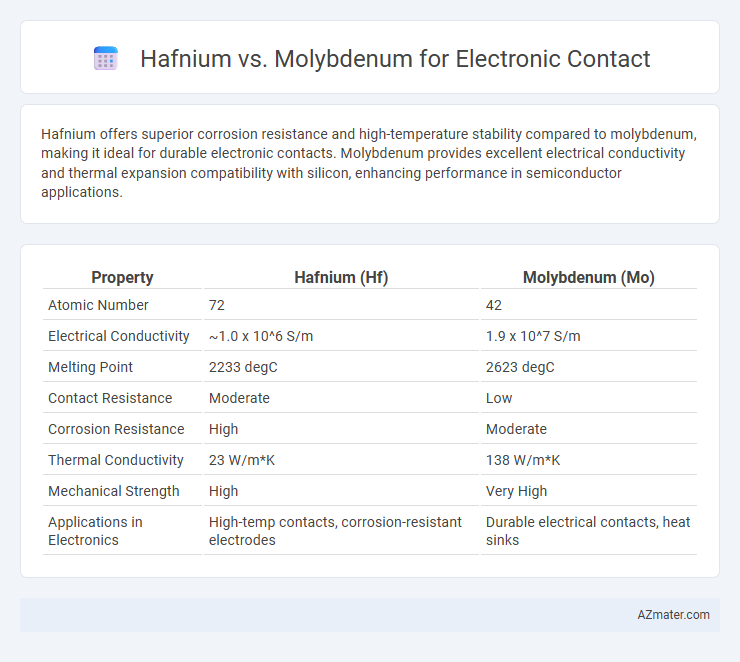Hafnium offers superior corrosion resistance and high-temperature stability compared to molybdenum, making it ideal for durable electronic contacts. Molybdenum provides excellent electrical conductivity and thermal expansion compatibility with silicon, enhancing performance in semiconductor applications.
Table of Comparison
| Property | Hafnium (Hf) | Molybdenum (Mo) |
|---|---|---|
| Atomic Number | 72 | 42 |
| Electrical Conductivity | ~1.0 x 10^6 S/m | 1.9 x 10^7 S/m |
| Melting Point | 2233 degC | 2623 degC |
| Contact Resistance | Moderate | Low |
| Corrosion Resistance | High | Moderate |
| Thermal Conductivity | 23 W/m*K | 138 W/m*K |
| Mechanical Strength | High | Very High |
| Applications in Electronics | High-temp contacts, corrosion-resistant electrodes | Durable electrical contacts, heat sinks |
Introduction to Hafnium and Molybdenum in Electronics
Hafnium and molybdenum are critical materials in electronic contacts due to their exceptional electrical conductivity and thermal stability. Hafnium exhibits a high melting point around 2,233degC and excellent resistance to corrosion, making it ideal for high-temperature electronic applications. Molybdenum offers a combination of low electrical resistivity and superior mechanical strength, which enhances durability and performance in semiconductor devices and electrical contacts.
Atomic Structure and Material Properties
Hafnium and molybdenum differ significantly in atomic structure and material properties, influencing their performance in electronic contacts. Hafnium, with an atomic number of 72 and a hexagonal close-packed structure, exhibits higher atomic mass and excellent corrosion resistance, enhancing contact durability under high temperature and oxidative environments. Molybdenum, atomic number 42 with a body-centered cubic crystal structure, offers superior electrical conductivity and mechanical strength, making it ideal for low-resistance, high-reliability electronic interfaces.
Electrical Conductivity Comparison
Hafnium and molybdenum both exhibit distinct electrical conductivity properties critical for electronic contacts, with molybdenum typically offering higher electrical conductivity around 18 x 10^6 S/m compared to hafnium's lower conductivity near 1.2 x 10^6 S/m. This significant difference makes molybdenum more suitable for applications requiring efficient electrical current flow and minimal resistive losses. Hafnium's lower conductivity is often balanced by its superior high-temperature stability and corrosion resistance in specialized electronic environments.
Thermal Stability and Heat Resistance
Hafnium exhibits superior thermal stability and heat resistance compared to molybdenum, maintaining structural integrity at temperatures exceeding 2200degC, which is critical for high-performance electronic contacts. Molybdenum, while durable up to around 1300degC, tends to oxidize and degrade faster under extreme thermal conditions common in power electronics. The refractory nature of hafnium, combined with its high melting point and excellent resistance to thermal cycling, makes it more suitable for demanding electronic contact applications requiring prolonged heat exposure.
Corrosion and Oxidation Resistance
Hafnium exhibits superior corrosion and oxidation resistance compared to molybdenum, maintaining stability at high temperatures due to its dense oxide layer that prevents further degradation. Molybdenum, while possessing good conductivity, tends to oxidize rapidly at elevated temperatures, forming volatile oxides that compromise its performance in electronic contacts. Therefore, hafnium is preferred in applications requiring prolonged exposure to aggressive environments and high thermal stress.
Mechanical Strength and Durability
Hafnium exhibits superior mechanical strength and excellent resistance to deformation, making it highly durable under high-stress electronic contact conditions. Molybdenum, while also strong, offers better thermal conductivity but slightly lower mechanical resilience compared to hafnium in demanding environments. The enhanced mechanical durability of hafnium ensures prolonged lifespan and reliable performance in electrical contacts subject to repeated mechanical stress.
Fabrication and Processing Compatibility
Hafnium offers superior compatibility with silicon-based fabrication processes due to its stable oxide formation and good adhesion properties, making it ideal for advanced electronic contacts in semiconductor devices. Molybdenum, while valued for its high melting point and excellent electrical conductivity, poses challenges in processing compatibility, such as diffusion issues and difficulties in thin-film deposition on certain substrates. Optimizing fabrication parameters for hafnium enables better integration in CMOS technology compared to molybdenum, enhancing device reliability and performance.
Cost and Availability in Market
Hafnium is significantly more expensive and less abundant than molybdenum, making molybdenum the more cost-effective option for electronic contacts. Molybdenum benefits from well-established mining and refining processes, ensuring steady availability and lower market volatility. The high cost and limited supply of hafnium restrict its use mainly to specialized applications despite its superior high-temperature properties.
Application Suitability in Modern Devices
Hafnium demonstrates superior performance in electronic contacts for modern devices due to its high melting point, excellent corrosion resistance, and ability to maintain stable electrical conductivity under extreme conditions. Molybdenum offers good thermal and electrical conductivity but is more prone to oxidation and wear, limiting its long-term reliability in high-stress applications. Devices requiring durable, high-performance contacts, such as semiconductor components and aerospace electronics, benefit more from hafnium's robust physical and chemical stability.
Future Trends and Technological Advancements
Hafnium's superior oxidation resistance and high melting point position it as a promising candidate for next-generation electronic contacts, particularly in high-temperature and high-voltage applications, outperforming molybdenum in durability and reliability. Emerging technologies such as advanced semiconductor devices and power electronics increasingly leverage hafnium's semiconductor compatibility and excellent thermal stability to enhance contact performance. Research into hafnium-based alloys and surface treatments aims to optimize electrical conductivity and mechanical strength, signaling a shift toward hafnium-dominant materials in cutting-edge electronic components.

Infographic: Hafnium vs Molybdenum for Electronic Contact
 azmater.com
azmater.com